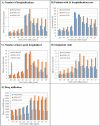Societal Costs Associated With Pulmonary Arterial Hypertension Subgroups: A Study Utilizing Linked National Registries
- PMID: 40248212
- PMCID: PMC12005055
- DOI: 10.1002/pul2.70074
Societal Costs Associated With Pulmonary Arterial Hypertension Subgroups: A Study Utilizing Linked National Registries
Abstract
Pulmonary arterial hypertension (PAH) is a heterogenic diagnosis including idiopathic and hereditary PAH (IPAH/HPAH) and groups associated to connective tissue disease (APAH-CTD) and congenital heart disease (APAH-CHD). Pre- and post-diagnosis societal costs in PAH subgroups are not well known. By linking Swedish national databases, societal costs in a national PAH cohort 5 years before and 5 years after diagnosis were estimated and compared to an age, sex, and geographically matched control group (1:5 match). Incident patients diagnosed 2008-2019 were included (patient/control; IPAH/HPAH = 393/1965, APAH-CTD = 261/1305, APAH-CHD = 89/445). Pre-diagnosis mean societal costs were 2.9, 3.4, and 4.3 times higher for IPAH/HPAH, APAH-CTD and APAH-CHD patients, respectively, than controls. Post-diagnosis, mean costs had increased 3.1, 2.0, and 1.6 times further for IPAH/HPAH, APAH-CTD and APAH-CHD respectively, while it decreased in all control groups. Main cost driver pre-diagnosis were indirect costs (productivity loss) in both patient and control groups, however, 2.7-4.5 times higher in the patient groups. Post-diagnosis, the main cost driver for all groups were health care costs (in- and outpatient-care, drugs) that had increased 7.8, 5.4 and 6.8 times for IPAH/HPAH, APAH-CTD and APAH-CHD, respectively. Corresponding increase for controls were 17%-48%. For the PAH groups, drug treatment accounted for 70%-81% of the direct costs, while hospitalizations were the main driver for the control groups. In conclusion, PAH was associated with large societal costs. Pre-diagnosis, APAH-CHD had the highest societal costs, both in relation to their control group and compared to the other patient groups. Post-diagnosis, highest societal costs were seen in IPAH/HPAH.
Keywords: health care resource utilization; national registry; productivity loss; pulmonary hypertension.
© 2025 The Author(s). Pulmonary Circulation published by John Wiley & Sons Ltd on behalf of Pulmonary Vascular Research Institute.
Conflict of interest statement
The authors declare no conflicts of interest.
Figures




Similar articles
-
Societal costs associated with pulmonary arterial hypertension: A study utilizing linked national registries.Pulm Circ. 2023 Jan 1;13(1):e12190. doi: 10.1002/pul2.12190. eCollection 2023 Jan. Pulm Circ. 2023. PMID: 36704610 Free PMC article.
-
Efficacy and Safety of Long-Term Oral Bosentan in Different Types of Pulmonary Arterial Hypertension: A Systematic Review and Meta-Analysis.Am J Cardiovasc Drugs. 2021 Mar;21(2):181-191. doi: 10.1007/s40256-020-00426-w. Am J Cardiovasc Drugs. 2021. PMID: 32918210
-
Four- and seven-year outcomes of patients with congenital heart disease-associated pulmonary arterial hypertension (from the REVEAL Registry).Am J Cardiol. 2014 Jan 1;113(1):147-55. doi: 10.1016/j.amjcard.2013.09.032. Epub 2013 Oct 4. Am J Cardiol. 2014. PMID: 24176071
-
Treatment of pulmonary arterial hypertension in connective tissue disease.Drugs. 2012 May 28;72(8):1039-56. doi: 10.2165/11633390-000000000-00000. Drugs. 2012. PMID: 22621693 Review.
-
Characterization of connective tissue disease-associated pulmonary arterial hypertension from REVEAL: identifying systemic sclerosis as a unique phenotype.Chest. 2010 Dec;138(6):1383-94. doi: 10.1378/chest.10-0260. Epub 2010 May 27. Chest. 2010. PMID: 20507945 Free PMC article.
References
-
- Humbert M., Kovacs G., Hoeper M. M., et al., “2022 ESC/ERS Guidelines for the Diagnosis and Treatment of Pulmonary Hypertension,” European Heart Journal 43 (2022): 3618–3731. - PubMed
LinkOut - more resources
Full Text Sources

